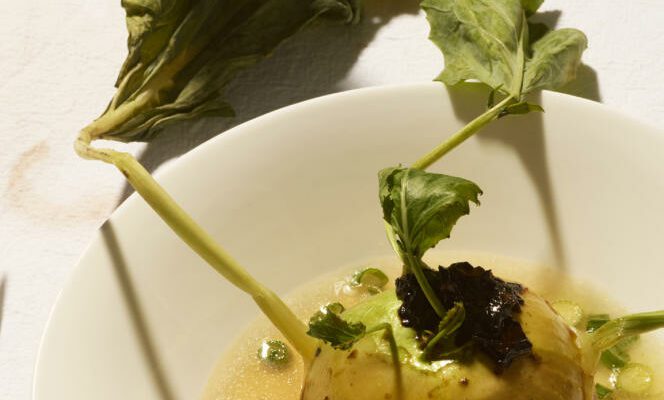Of all the Parisian chefs, William Ledeuil is undoubtedly the one who best knows how to combine inspiration from here and elsewhere, French culinary techniques and flavors from afar. With powerful and just condiments, it sublimates the most banal of vegetables, marrying, for example, earthen kohlrabi with delicately iodized seaweed.
Ingredients for 4 persons
Seaweed butter. 250 g semi-salted butter, 60 g seaweed flakes (dulse, wakame, nori).
Seaweed jam. 10 sheets of nori seaweed, 120 g of wakame seaweed, 100 g of very finely chopped shiitake mushrooms, 8 cl of soy sauce, 20 cl of water, 4 cl of rice vinegar, 4 cl of mirin, 1 stick of lemongrass , 1 C. at s. sesame oil, Timut pepper.
The dish. 12 small kohlrabi, 60 g of seaweed butter, 15 cl of vegetable stock, ½ stick of lemongrass, 1 minced spring onion, juice of ½ lemon, 50 g of seaweed jam, salt, pepper.
Preparation
Seaweed butter. Mix the butter and dehydrated seaweed with a spatula. Pour onto parchment paper and shape into a roll. Put in the freezer for one hour. Take a fifth for the recipe, leave the rest in the freezer for later uses.
Seaweed jam. Cut the nori sheets into small squares. Put all the seaweed, mushrooms, soy sauce, water, rice vinegar, mirin, lemongrass stick cut in half in a saucepan. Give a turn of the pepper mill. Leave to swell for half an hour.
Then bring to a simmer, stirring regularly, and simmer for 45 minutes. The consistency becomes thick like a tapenade. Off the heat, stir in the sesame oil and leave to cool. Take 50 g for the recipe, put the rest in the fridge.
Peel the kohlrabi to three quarters, keeping the base of the leaves. Place them whole in a sauté pan with the seaweed butter, vegetable broth, half a lemongrass stick, salt and pepper. Cook the kohlrabi over low heat for 20 minutes. They should be tender.
Reserve the kohlrabi, bring the cooking juices to a boil. Add the minced chives and lemon juice. Coat the kohlrabi with this juice and serve with the seaweed jam.
The Plant, by William Ledeuil, La Martinière, 2020, 304 p., €39.90. Ze Kitchen Gallery, 4, rue des Grands-Augustins, Paris 6e. KGB/Kitchen Gallery Bis, 25, rue des Grands-Augustins, Paris 6e. zekitchengalerie.fr
Most produced
Nicknamed “Pompeii cabbage” by the Romans, then “colrave”, “Siam cabbage”, “Siam ball”, Brassica oleracea is a food of war, just like Jerusalem artichokes or rutabagas. No doubt for this reason, kohlrabi has been somewhat neglected by the French consumer, whereas it is very common in Germany, Central Europe and Canada. Unlike rutabaga or kohlrabi, with which it is often confused, kohlrabi is not a root vegetable: it is above all its swollen, round and fleshy stem, growing above the ground, that we consumes. White, purple or pale green, it has been known since Antiquity, and cultivated in Europe since the 8the century, and depending on the variety, it is sown from February, at the beginning of summer for the early varieties. The harvest is spread out from autumn to spring. Hardy, kohlrabi requires little care: it appreciates the sun, tolerates light frosts, and must be watered regularly to remain tender.
